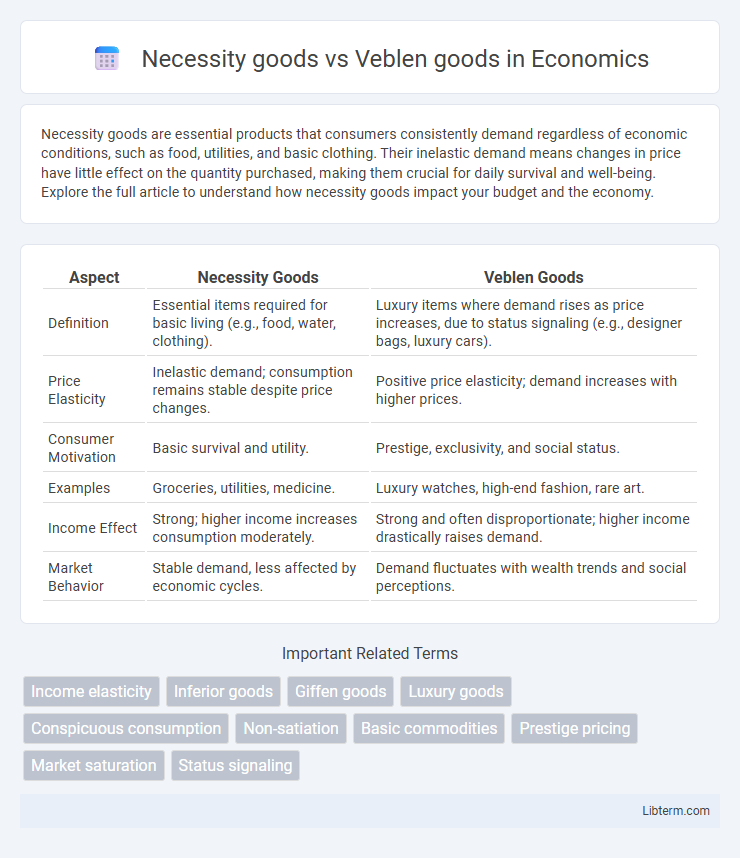Necessity goods are essential products that consumers consistently demand regardless of economic conditions, such as food, utilities, and basic clothing. Their inelastic demand means changes in price have little effect on the quantity purchased, making them crucial for daily survival and well-being. Explore the full article to understand how necessity goods impact your budget and the economy.
Table of Comparison
| Aspect | Necessity Goods | Veblen Goods |
|---|---|---|
| Definition | Essential items required for basic living (e.g., food, water, clothing). | Luxury items where demand rises as price increases, due to status signaling (e.g., designer bags, luxury cars). |
| Price Elasticity | Inelastic demand; consumption remains stable despite price changes. | Positive price elasticity; demand increases with higher prices. |
| Consumer Motivation | Basic survival and utility. | Prestige, exclusivity, and social status. |
| Examples | Groceries, utilities, medicine. | Luxury watches, high-end fashion, rare art. |
| Income Effect | Strong; higher income increases consumption moderately. | Strong and often disproportionate; higher income drastically raises demand. |
| Market Behavior | Stable demand, less affected by economic cycles. | Demand fluctuates with wealth trends and social perceptions. |
Understanding Necessity Goods: Definition and Examples
Necessity goods are essential items that consumers consistently purchase regardless of income changes, such as food, basic clothing, and utilities. These goods exhibit inelastic demand, meaning their consumption remains relatively stable even during economic fluctuations. Understanding necessity goods is crucial for businesses and policymakers to gauge consumer behavior and economic stability.
What Are Veblen Goods? Characteristics and Context
Veblen goods are luxury items for which demand increases as the price rises, defying typical economic principles. These products, often associated with high social status, include designer handbags, luxury cars, and exclusive watches, reflecting conspicuous consumption and prestige signaling. Unlike necessity goods, Veblen goods emphasize brand image, rarity, and exclusiveness as key characteristics driving consumer desire and market value.
Key Differences Between Necessity and Veblen Goods
Necessity goods are products essential for daily living, such as food, water, and basic clothing, with demand remaining stable regardless of price changes, showcasing inelastic demand. Veblen goods, like luxury designer handbags or high-end sports cars, experience increased demand as their prices rise due to their status symbol appeal, demonstrating a positive price elasticity of demand. The fundamental difference lies in consumer motivation: necessity goods fulfill basic needs, while Veblen goods fulfill desires for prestige and social status.
The Economic Importance of Necessity Goods
Necessity goods, essential for daily living such as food, water, and basic clothing, exhibit inelastic demand, meaning consumers buy these goods regardless of price fluctuations. Their economic importance is critical as they ensure population sustenance and stability, maintaining consistent market demand even during economic downturns. This contrasts with Veblen goods, luxury items whose demand increases with higher prices, driven by status rather than utility.
Consumer Behavior and Veblen Goods: Why They Pay More
Necessity goods satisfy fundamental consumer needs, exhibiting inelastic demand as consumers prioritize these items regardless of price fluctuations. Veblen goods defy typical demand patterns, with higher prices increasing desirability due to their status-symbol appeal and exclusivity. Consumer behavior around Veblen goods reveals a preference for conspicuous consumption, where paying more signifies wealth and prestige, driving demand despite premium pricing.
Pricing Strategies: Necessity vs. Veblen Goods
Pricing strategies for necessity goods emphasize affordability and consistent demand, often using cost-plus or competitive pricing to maintain consumer accessibility and volume sales. Veblen goods rely on premium pricing as a status symbol, where higher prices increase desirability and signal exclusivity, leveraging scarcity and brand prestige. While necessity goods focus on functional value to drive repeat purchases, Veblen goods capitalize on perceived luxury to create aspirational consumption.
Market Demand: How Necessity and Veblen Goods Respond
Necessity goods exhibit inelastic demand, meaning their consumption remains relatively stable regardless of price fluctuations due to essential daily use, such as basic food and utilities. Veblen goods show a positive price-demand relationship, with higher prices increasing their desirability as status symbols, leading to a higher market demand among luxury consumers. In economic analysis, the contrasting demand elasticity between necessity and Veblen goods highlights consumer behavior driven by utility needs versus prestige consumption.
Societal Implications of Necessity and Veblen Goods
Necessity goods, essential for basic living such as food and clothing, contribute to social stability and equitable access, influencing public policy on affordability and welfare. Veblen goods, luxury items whose demand increases with price due to their status symbol effect, often highlight and exacerbate social inequalities, promoting conspicuous consumption among wealthier classes. The societal implications include potential divides in wealth perception and economic behavior, with necessity goods underpinning social welfare while Veblen goods emphasize status-driven consumption patterns.
Case Studies: Necessity Goods vs. Veblen Goods in Real Life
Case studies illustrating necessity goods include staple foods like rice and basic clothing, which maintain consistent demand regardless of price changes due to their essential nature for daily living. In contrast, Veblen goods such as luxury watches, designer handbags, and high-end sports cars experience increased demand as their prices rise, driven by their status symbol value and exclusivity. Market analyses of these goods reveal that necessity goods exhibit price inelasticity, while Veblen goods demonstrate a positive price elasticity of demand, reflecting consumer behavior influenced by social prestige.
Future Trends: Evolving Perceptions of Necessity and Luxury
Future trends indicate a blurring distinction between necessity goods and Veblen goods as consumer perceptions evolve with technological advancements and shifting cultural values. Smart devices, once luxury items, are increasingly viewed as essential, while certain luxury brands emphasize sustainability and exclusivity to maintain their status. This dynamic shift highlights a growing overlap where necessity goods acquire aspirational qualities and Veblen goods integrate functional value.
Necessity goods Infographic

 libterm.com
libterm.com